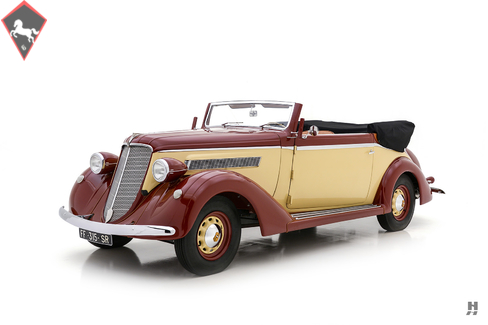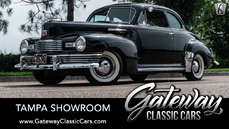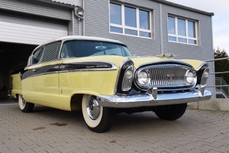Nash Ambassador Gläser Cabriolet 1935
General description :
Of all the American independents, Nash of Kenosha, Wisconsin, has a particularly fascinating story. Company founder Charles Nash is a genuine “rags-to-riches” character who ran away from indentured servitude at the age of 12, eventually landing a job as a cushion stuffer at Flint Road Cart Company, owned by William C. “Billy” Durant and J. Dallas Dort. Streetwise and hard-working, Nash steadily rose through the ranks, winding up as manager of the Durant-Dort Carriage Company. Working closely with Durant, Nash was put in charge of Buick by 1910 and managed all of General Motors just two years later. However, like most people in Durant’s inner circle, the two men had a falling out, and Nash left GM to strike out on his own.
Charles Nash acquired the remains of the Thomas B. Jeffery Company (producers of the original Rambler) and formed Nash Motors Company in 1916. The first few cars were leftover models badged as Nashes to use up existing stock, so it wasn’t until 1918 that the first pure Nash hit the market. Buyers and critics commended the new Nash for its neat and tidy styling, refined Cardan-drive drivetrain, and powerful overhead-valve engine designed by former Buick engineer Erik Wahlberg. Nash quickly earned a reputation for high-quality, stylish cars at competitive prices and was often in direct competition with Hudson in the mid-priced market. In the 1930s, the influential designer Alexis de Sakhnoffsky worked with Nash to create a line of beautiful, streamlined bodies that complemented the powerful six and eight-cylinder engines. The top-of-the-line Ambassador was particularly stylish, with deeply skirted fenders and a flowing, fastback roofline reminiscent of the Chrysler Airflow. In classic Nash tradition, the Ambassador’s 260.8 cubic-inch inline-eight featured overhead valves and delivered its 100 horsepower with notable refinement. The advanced and robust drivetrain earned it a loyal following, even finding favor with European buyers who appreciated the Ambassador’s lively performance, durability, and value.
This fascinating 1935 Nash Ambassador Cabriolet is one of a mere handful of Nash automobiles in history to feature bodywork by an outside coachbuilder. Even more unusual is this Ambassador’s European origins, and it’s distinctive coachwork by the highly-respected firm Gläser-Karosserie GmbH of Dresden, Germany. First registered in Denmark in August 1935, little is known of the first owner. Gläser was a fitting choice to provide the coachwork for the big eight-cylinder Nash, as they had a long tradition of creating high-quality bodies for prestigious marques like Daimler, Horch, Steyr, and others. They also bodied a select few American cars, and the well-engineered Nash platform suited their style and quality. This example is understood to be the only one of its kind; however, Gläser’s production records did not survive World War II.
After being hidden away during the war, the Nash-Gläser quietly remained in Denmark for many years. It resurfaced and was acquired by a renowned collector of rare and unusual Nashes. Following the acquisition, he commissioned an extensive, ground-up restoration, performed by a noted specialist in Europe. Time had taken its toll on the structural woodwork, which restorers methodically recreated using the original pieces as patterns. The restoration team worked to preserve as much of the original sheet metal as possible, recreating new segments only when necessary. The owner selected a suitably bold color scheme of maroon and cream, with matching two-tone wheels and a tan interior to complement the car’s Art Deco origins. Since completion, the restoration has taken on a pleasant character with use, and it wonderfully suited to regular enjoyment or show. The striking livery suits the design quite well, and recently-installed period-correct black wall bias-ply tires round out the authentic presentation.
The European influence of the coachwork carries over into the five-passenger cabin. Substantial, vault-like doors open to reveal individual front seats trimmed in lovely natural tan leather upholstery. Door panels, rear seats, and carpet bindings feature the same matching leather. The bold woodgrain-effect dash is a distinctly American feature, with art-deco detailing and beautiful center-mounted rectangular instruments – including a speedometer calibrated in kilometers. Other noteworthy details include gorgeous wood door caps, curved Perspex visors, and a sporty Bluemels Brooklands steering wheel. The black canvas top is in good condition and features a matching canvas boot cover.
Beneath the hood sits the powerful and refined 260.8 cubic-inch overhead valve Nash inline-eight. It is well-detailed, showing good quality paintwork with period-correct fittings and hardware. The goal of the restoration was to create a good looking and equally good performing car for road events and rallies. The previous owner reported a trouble-free run in a 500-mile rally shortly after completing the project, and in 2020, it participated in the Amelia Island Concours d’Elegance, reflecting both the quality of the restoration and the robust Nash underpinnings. The Classic Car Club of America granted it Full Classic status, putting it in a select group of cars from Kenosha to receive that honor. It shows today in excellent order, suitable for continued enjoyment in tours and shows, and would be a splendid addition to a collection of American Independents or other rare coachbuilt motorcars.
Offers welcome and trades considered
https://hymanltd.com/vehicles/6682
1935 Nash Ambassador Gläser Cabriolet is listed sold on ClassicDigest in St. Louis by Mark Hyman for $139500.
Car Facts
Car type : Car Make : Nash Model : Ambassador Model Version : Gläser Cabriolet Engine size : 0.0 Model Year : 1935 Sub type : Convertible Location : Missouri
Sold
Seller Information
Sold
People who viewed this Nash Ambassador also viewed similar Nash listed at ClassicDigest
Other cars listed for sale by this dealer
About Nash
Nash Motors, a smaller American manufacturer in comparison to the dominant Detroit "Big Three" automakers (General Motors, Ford, and Chrysler), had its unique identity and history, setting itself apart in several ways:Identity and Distinctions of Nash Motors:
Innovative Features: Nash was known for its pioneering approach to automotive engineering, introducing several innovative features ahead of its time.
Unconventional Design: The company often embraced unconventional designs, including aerodynamic shapes and distinctive styling cues.
Emphasis on Comfort: Nash prioritized passenger comfort, offering spacious interiors and advanced heating and cooling systems.
Advanced Safety Features: They were among the first to incorporate safety features like padded dashboards and seatbelts into their vehicles.
Economic and Fuel-Efficient Cars: Nash cars were recognized for their fuel efficiency and reliability, appealing to a segment of the market seeking economical transportation.
Ten Significant Nash Models with Tech Specs:
Nash Rambler (1950): An early compact car, the Rambler was known for its small size, featuring a 173.3 cubic inch, 82 hp engine, and achieving approximately 25 mpg.
Nash Metropolitan (1953): A subcompact car with a 1.2L engine, it had an economical 42 hp and remarkable fuel efficiency, achieving around 30-40 mpg.
Nash Ambassador (1949-1957): A full-sized car available in various body styles, equipped with a powerful 234 cubic inch, 112 hp engine.
Nash Statesman (1949-1956): Another full-sized model featuring a 184 cubic inch, 85 hp engine and a spacious interior design.
Nash-Healey (1951-1954): A sports car collaboration between Nash and Healey, powered by a 252 cubic inch, 125 hp engine, offering impressive performance for its time.
Nash Airflyte (1949-1951): These models featured a streamlined body design, powered by engines ranging from 172 to 184 cubic inches, producing 82 to 85 hp.
Nash Ambassador Custom (1956): Equipped with a V8 engine of either 250 or 320 cubic inches, offering horsepower in the range of 190-208 hp.
Nash 600 (1941-1949): Introduced before WWII, this model had a 172 cubic inch, 82 hp engine, and a streamlined design for its era.
Nash Lafayette (1934-1940): These models incorporated various engine sizes, ranging from 221 to 234 cubic inches, producing 72 to 95 hp.
Nash Advanced Eight (1933-1934): Featured an inline-eight engine with 298 cubic inches, delivering around 125 hp, an advanced feature for its time.
These Nash models, each with its unique attributes, contributed to the company's reputation for innovation, comfort, and fuel efficiency in the automotive industry.
User
great, same without the bullets
ChatGPT
Certainly, here is a version without bullet points:
Identity and Distinctions of Nash Motors:
Nash Motors, a smaller American manufacturer in comparison to the dominant Detroit "Big Three" automakers (General Motors, Ford, and Chrysler), had its unique identity and history, setting itself apart in several ways:
Innovative Features: Nash was known for its pioneering approach to automotive engineering, introducing several innovative features ahead of its time.
Unconventional Design: The company often embraced unconventional designs, including aerodynamic shapes and distinctive styling cues.
Emphasis on Comfort: Nash prioritized passenger comfort, offering spacious interiors and advanced heating and cooling systems.
Advanced Safety Features: They were among the first to incorporate safety features like padded dashboards and seatbelts into their vehicles.
Economic and Fuel-Efficient Cars: Nash cars were recognized for their fuel efficiency and reliability, appealing to a segment of the market seeking economical transportation.
Ten Significant Nash Models with Tech Specs:
Nash Rambler (1950): An early compact car, the Rambler was known for its small size, featuring a 173.3 cubic inch, 82 hp engine, and achieving approximately 25 mpg.
Nash Metropolitan (1953): A subcompact car with a 1.2L engine, it had an economical 42 hp and remarkable fuel efficiency, achieving around 30-40 mpg.
Nash Ambassador (1949-1957): A full-sized car available in various body styles, equipped with a powerful 234 cubic inch, 112 hp engine.
Nash Statesman (1949-1956): Another full-sized model featuring a 184 cubic inch, 85 hp engine and a spacious interior design.
Nash-Healey (1951-1954): A sports car collaboration between Nash and Healey, powered by a 252 cubic inch, 125 hp engine, offering impressive performance for its time.
Nash Airflyte (1949-1951): These models featured a streamlined body design, powered by engines ranging from 172 to 184 cubic inches, producing 82 to 85 hp.
Nash Ambassador Custom (1956): Equipped with a V8 engine of either 250 or 320 cubic inches, offering horsepower in the range of 190-208 hp.
Nash 600 (1941-1949): Introduced before WWII, this model had a 172 cubic inch, 82 hp engine, and a streamlined design for its era.
Nash Lafayette (1934-1940): These models incorporated various engine sizes, ranging from 221 to 234 cubic inches, producing 72 to 95 hp.
Nash Advanced Eight (1933-1934): Featured an inline-eight engine with 298 cubic inches, delivering around 125 hp, an advanced feature for its time.
These Nash models, each with its unique attributes, contributed to the company's reputation for innovation, comfort, and fuel efficiency in the automotive industry.
























